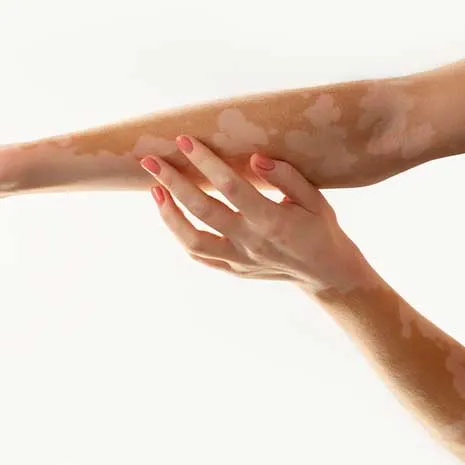What is Vitiligo? Symptoms, Causes, and Treatment Options

What is Vitiligo? Symptoms, Causes, and Treatment Options
- 1 July 2025
- 285

Understanding Vitiligo
Vitiligo is a chronic autoimmune skin disorder that results in the loss of pigmentation in certain areas of the skin. It occurs when melanocytes—cells responsible for producing melanin—are destroyed or stop functioning. This leads to the appearance of distinct milky-white patches on various parts of the body. Although vitiligo can affect people of all ages and ethnic backgrounds, it typically begins between the ages of 10 and 30. The condition is not contagious and does not cause direct physical harm, but it can significantly impact a person’s psychological and emotional well-being.
Common Symptoms of Vitiligo
The hallmark symptom of vitiligo is the appearance of well-defined, white patches on the skin. These patches are often symmetrical and may remain stable or gradually expand. Common signs include:
- White patches on the hands, face, feet, and around the lips
- Loss of pigmentation in the mouth, nose, and genitals
- Premature whitening of hair, eyebrows, eyelashes, or beard
- Depigmentation around the eyes or in mucosal areas
- Rarely, discoloration or transparency in the nails
Depending on the type and severity, vitiligo may appear in localized areas or affect large portions of the body.
What Causes Vitiligo?
The exact cause of vitiligo remains unclear, but researchers believe that a combination of autoimmune, genetic, and environmental factors plays a role.
1. Autoimmune Reaction
The leading theory suggests that the immune system mistakenly attacks the body’s own melanocytes, leading to pigment loss.
2. Genetic Predisposition
About 20% of vitiligo patients have a family history of the condition. Certain genetic mutations are associated with increased risk.
3. Oxidative Stress
High levels of free radicals in skin cells may damage melanocytes and contribute to vitiligo development.
4. Neurogenic Factors and Trauma
Chemicals released from nerve endings or physical trauma to the skin (e.g., cuts, pressure) can act as triggers. This is known as the Koebner phenomenon.
Types of Vitiligo
Vitiligo is categorized based on the distribution and extent of the depigmented patches:
- Generalized vitiligo: The most common type; patches appear symmetrically across the body
- Segmental vitiligo: Usually begins at a young age and is localized to one area
- Focal vitiligo: Limited to a few small spots in one region
- Mucosal vitiligo: Affects only the mouth, genitals, or other mucous membranes
- Universal vitiligo: A rare form that involves almost the entire body surface
Treatment Options for Vitiligo
While there is no permanent cure for vitiligo, several treatment methods aim to stop progression and restore pigment. The approach is individualized based on patient age, vitiligo type, and severity:
1. Topical Treatments
- Corticosteroid creams: Useful in early-stage lesions, especially in localized areas
- Calcineurin inhibitors (e.g., tacrolimus): Effective on delicate areas like the face and neck
2. Phototherapy
- Narrowband UVB: The gold standard for vitiligo; usually administered 2–3 times per week
- PUVA therapy: Combines UVA exposure with psoralen medication
3. Systemic Therapies
- Immunosuppressive drugs may be used in widespread or rapidly progressing cases
4. Emerging Therapies
- JAK inhibitors: A promising new class of drugs under clinical investigation
- Stem cell therapy and PRP (Platelet-Rich Plasma): Experimental but gaining traction
5. Surgical Options
- Micrografting or melanocyte transplantation may be considered for stable, localized vitiligo
Supportive Approaches in Vitiligo Management
- Sun protection: SPF 50+ sunscreen is essential to prevent sunburn on depigmented skin
- Psychological support: Counseling and support groups can improve mental health outcomes
- Nutritional support: Supplementation with vitamin B12, D, folic acid, and zinc may be beneficial
Frequently Asked Questions
No. Vitiligo is not an infectious disease and cannot be transmitted through contact.
While there is no definitive cure, treatments can halt its progression and restore some pigmentation.
No. Vitiligo does not cause skin cancer, but the affected skin is more prone to sun damage.
It is typically a chronic condition, but some patches may spontaneously repigment.
Not necessarily. Hypoallergenic, fragrance-free, and non-comedogenic products are generally safe.
